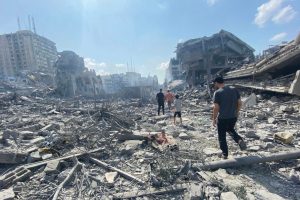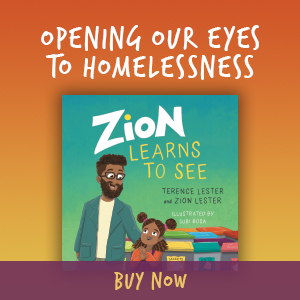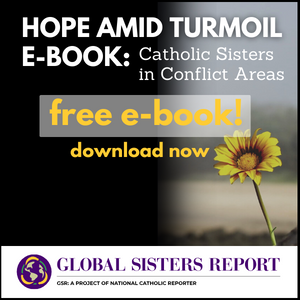Catholic Relief Services circles the globe to provide life-changing aid, but it doesn’t have to look far for inspiration—there is plenty in the gospel.
“A lot of my colleagues have worked in a development context. I did not, but I actually grew up in one,” says Woo. As the daughter of Chinese immigrants who set out for a new life in Hong Kong, she grew up in a region where development efforts helped people begin successful new lives.
“I have this deep faith that development works because I grew up in such a successful model of it,” she says. “I didn’t just work in that context. My family, we were part of the lives that flourished and built a whole new incredible economy.”
After coming to the United States as a college student, Woo earned a Ph.D. in strategy from Purdue University. Those strategic planning skills have prepared her well to lead the agency founded by the U.S. bishops in 1943 to provide aid to people in need worldwide, a job that she does not take lightly.
“To be able to play a role in bringing about a tomorrow, a future for people, that is a privilege,” she says.
How did your background prepare you for your work with CRS?
I grew up in Hong Kong, and my parents and the parents of most of my friends were displaced from China. Starting from World War II, and of course with the Communist takeover, there were millions of people who left home, and a lot of assets people had were tied to their land, their ancestral home. Most people left their assets, whatever possessions they had, to start over in Hong Kong.
So I grew up in a context where I saw the best model of development. I saw a lot of problem solving and got a sense of how government and civil society working together, when it’s done intelligently, can create a future for people.
Of course, that environment was also very multicultural. The majority were Chinese people living in a British system. You had the Eastern culture and the Western culture operating together. You had a highly capitalistic economy living right next door to a communist system. We just didn’t mingle a lot.
It was incredible to see so many different things coexisting, a lot of the different cultures operating together. You had Buddhists and Hindus and so on, and I went to a Catholic school.
What influence did your Catholic education have on you?
I was a product of the best that the church had to offer. I was educated by missionary sisters from the United States called the Maryknoll Sisters. They were these very well-educated women from comfortable families who started going overseas in 1912.
There was a group of them who came to China at first when there was yellow fever. Then they were kicked out by the Communists, too, so they started more schools in Hong Kong. I was educated by these women. It’s pretty incredible that a group of strangers would make it their life’s work to educate these girls.
When you’re in third grade, you just want to see whether the nuns really have hair or not under their habit. But by the time you get to high school, you begin to appreciate the why and what for. God is so real to these women, otherwise their ministry would not make sense. Their love of God was the love of people, and we were the beneficiaries.
That was my sense of the church at its best in terms of ministry. What it looks like, how it affects people, and how the faith is lived out.
How does that sense of ministry play out in the work of CRS?
CRS was created as a commitment to the gospel by the Catholic bishops of this country. It is specifically the commitment to serve the poorest and most vulnerable in the world.
Because of that, we serve anyone who is in need, regardless of country, regardless of their faith. We serve on a basis of need, not on the basis of creed. It’s as simple as that. Our idea is to serve out of faith and of course to do it with excellence.
It is exhilarating to do the work that we do, to have this type of impact and to make a difference. It’s not just to help people live better lives, it is to help them live, period. The absence of clean water can kill. The absence of vaccines kills. The absence of nutrition for young children leads to terrible stunting of growth.
What is overwhelming is the immense scope of our work, both geographically—we are in about 100 countries—and in the breadth of our programming portfolio. Our work covers a plethora of programs.
In emergencies we deal with shelter, food, water, sanitation, child protection. Then we move into livelihood: education, nutrition, peacebuilding. I don’t think there’s much in the scheme that we do not do.
We follow a model which is called integral human development, and that’s very Catholic. Integral human development, if you boil it down, is really to serve everyone and to serve the whole person in a system which is just.
What about evangelization? Why don’t you preach the gospel, too?
We preach the gospel by our service, not by our words. We contribute to the new evangelization as we offer a witness of God’s love on behalf of the Catholic community in the United States.
We cannot make our service conditional on people accepting our God. We render that service out of love, and that love first comes from God. That’s the best way we give witness. Pope Benedict XVI, in his encyclical Deus Caritas Est (God is Love), said love and service cannot be conditional.
What happens when you go into countries that might not be friendly toward Catholics?
We work in a lot of countries that are not necessarily the most receptive of Catholics and Christians, and sometimes they are not very receptive of Americans. The bottom line is that you have to respect people’s culture. You have to respect people’s beliefs. You have to respect their need for dignity and a sense of sovereignty, too.
Just because you’re bringing assistance doesn’t mean you can give the signal that you are better than they are. If your agenda is clear, and your agenda is really to help, you have to help in such a way that there is respect.
Then you gain local acceptance. We’ve worked in some very difficult places for 50 or 60 years, countries that are not Christian. I think there’s a trust that has developed.
Can you give an example of a more challenging country you work in?
We started serving in Afghanistan around 2003 or 2004. We don’t work in the front-line battle provinces, we work a little bit away from the battle lines.
But nevertheless, in a country where receptivity to Americans and Christians is not high, we used the same approach: that we are there to be of service and to help people’s lives become better while being very respectful of their customs.
That’s the key. It’s as simple as that. Our purpose is to serve those in need and to have deep respect for the people we are serving. And you also have to
do good work, and you’ve got to be highly effective.
Are there any places that you haven’t been able to go yet where you might want to establish a presence?
There are troubled territories right now in the world where it’s very difficult to provide aid. Clearly in Syria there are a lot of people who are suffering. The border between Sudan and South Sudan is a very difficult area. In North Korea people are starving and aid cannot get in there. The Middle East is another one.
There are probably others where we see broad and deep suffering where aid cannot reach, and people die in those situations.
What kinds of local partnerships do you develop in the countries where CRS operates?
We have both Catholic and non-Catholic partners. There are several benefits to this broad partnership model.
Clearly it gives us the breadth of coverage in different countries. The Catholic Church is almost everywhere–it’s not totally everywhere, but it’s almost everywhere. It is present even in fairly remote villages and, most important, in very poor communities.
Working with the local church gives us the breadth and it gives us the depth, so that we can really serve people who are vulnerable and isolated, sometimes really cut off from any type of sustaining structures, whether it’s health structures, education structures, or market structures.
So why the need to work with non-Catholic partners as well?
One benefit is the ability to have access. With our non-Catholic partners, again, our goal really is to serve the very poor and the most vulnerable. For programs where the church either is not there or does not have the expertise, then we access other partners. But whoever those partners are, we make sure that all the work that we do with that particular partner is completely in alignment with the teachings of the Catholic Church.
The first benefit, of course, is the people that we could reach. The second benefit is that for interventions to be sustainable, they have to be owned by the local people and the people who will stay there. The most important thing is that the local church, the local civil society, and local government ministries feel a sense of ownership for that work. That’s a very important driver of sustainability.
A third benefit is that when you work with partners, you learn from them. You learn to listen to the local communities a lot better. You learn to develop the sensitivity to that culture, that we’re not just Americans parachuting into a place and rendering service, but we are working with local organizations and marrying the expertise that we bring to their understanding of what works. It allows the solutions to be much better.
In the process, as we work with the Catholic partners in particular, we are building up the capacity of the global church. Hopefully all our local partners develop and grow in their expertise because of our work together.
Learning does not just go one way, but both ways. We learn from them. They learn from us. In the process, we build up the church institutions and the capacity for service.
Does being a Catholic organization that works in secular circles ever cause any roadblocks?
Oh, yes. For example, it comes up with our applications for competitive grants. In an average year, 85 percent of our grants come from some type of competitive proposal process.
There are some requests for grant proposals where there are stipulations to provide contraceptives. We don’t apply for those grants.
Sometimes we push back and ask, for example, “Why are these criteria necessary? How does this relate to a water sanitation project?” The push back in some cases has lead to revisions of those criteria. While those criteria are in place, those grants are off the table to us.
When there are grants that we feel align with our values, then we apply for them. Yes, there may be a smaller universe of grants to apply for, but it’s still a big enough universe for us.
The bottom line is we don’t exist as just a humanitarian agency. We exist to bring the love of God into the world, and there’s a particular way that we believe is manifesting the love of God and other ways which are not.
For us, it’s important not only to win the grant, but in the end we’re supposed to serve the poor with excellence. And when we win our grants, it’s not because people think that we’re just good-hearted souls. It is because we are good.
Can you give an example of how CRS carries out that mission of serving the poor with excellence?
One initiative is providing access to capital for people who cannot afford loans. If you’re a farmer, you need to buy seed before you have any harvest. Or if you want to have an egg business, you’ve got to have money to buy chickens first. One very popular source is what is called microfinance, offering microloans of $25 or $50 that allow people to start things.
That’s a wonderful creation. Muhammad Yunus got a Nobel Prize for that. But in a lot of places, even such microloans create too much risk for farmers. And a lot of women don’t have access even to those microloans.
A while back CRS realized that microloans themselves are more risky than what our beneficiaries could handle. So we offer an alternative, called Savings and Internal Lending Communities (SILC). The whole idea is no matter how poor you are, if we gather people, like 20 or 30 people together, and every week or month consistently they give whatever they can—even if it is 25 cents or 50 cents—then together they would be able to have a pool of money and they could take turns accessing it.
That’s why it’s called internal savings and internal lending. It’s internal to this group. You don’t have to deal with that massive interest rate, you just pool your money and the groups set the rules for lending themselves.
Sometimes you can choose to lend to someone outside of the circle. There is actually an encouragement to lend the money out, because that’s how you make investments. By charging a modest interest, you could make a profit.
Is this concept a new idea?
The concept is not new, but the implementation requires innovation.
I saw this working with my mother and aunt in Hong Kong. They would get together and talk about whether they had collected money from so and so, and who wants to bid for the money that month. I saw what it allowed these women to do. Sometimes they could have enough for a down payment on a house.
Hong Kong had a booming market, so once you put in a down payment, then you could collect rent. Sometimes people bought stocks. Sometimes people used the money to send their children overseas for school. Actually, this is a folk model which exists in certain cultures.
What CRS did was that we took that concept and scaled it up and provided the training. How do you organize 30 people if they don’t know arithmetic? What type of training do you give them? How do you teach them to manage money? How do you develop social norms and enforce these?
It gives them a sense of empowerment when they actually have capital, and also acts as an incentive to learn numbers. Of course, because you can now lend other people money, you also become more aware of where the opportunities are.
Is this model primarily aimed at helping women?
About 80 to 90 percent of those in the lending communities are women. In one community we visited, I believe in Cambodia, the women were all from the Legion of Mary.
It is really a way of empowering women. They have no access to microloans. We found in our research that most of these people have no access to the banking infrastructure, partially due to distance and partially because of cultural reasons.
How successful have the Savings and Internal Lending Communities been?
We started this about seven years ago, and we now have 1 million participants. The total amount of money that they were able to save and lend out is U.S. $7 million. These are very poor people. That’s why we’re really proud of this.
Some of the people have bakeries. There was a bakery where the members thought they had enough materials to operate for three months.
They sold out everything in one week. It was that popular. They sold cakes to the local police department, so the idea that police love donuts is a global thing. The leader of the group lost a child to starvation before this enterprise.
I met a group of women who made curtains for the most basic dwellings, and business has flourished.
These groups of 20 or 30 people now become very natural units for implementing other programs: health, nutrition, some type of social action programs. They organize them.
If there’s an issue with abuse in the local community, they become a natural group to work with. There are a lot of benefits associated with that. For these benefits, we integrate SILC into many of our programs.
We realized that this model is so popular we need to do it on a larger scale. But we would never raise enough money or hire enough people to scale up to the level that it has potential for, so we created what we call a “private service provider” or PSP model.
What is that?
The PSP model is where certain members of the SILC groups get certified by us, and then they can go and start more groups and be paid to do it. It’s not quite a career, it is more of a side job. But once you’re certified, you go work with a lot of groups and you can also take on apprentices. The apprentices could also get certified.
We did the research and found that groups will actually pay someone to work with them, either to help new groups get started or to help existing groups become more advanced. We’re actually creating new opportunities for people. It’s passing on to others so that the work can grow beyond CRS. It’s a very exciting development for us.
Innovation is critical and ongoing. The nature of problems changes, so does the technology and know-how. And we must therefore learn, invent, and change so that we can bring our best to the people we serve.
How important is it to keep up with technological innovations?
One of the big bugaboos in the development field is that donors always ask, “What is the impact in what you’ve done?” That requires a level of monitoring that is really comprehensive and hasn’t existed before.
We now are piloting a monitoring program in our Eastern Africa region. We assign a bar code to everyone we serve, or to every family, so we can track everyone. Our field people now use mobile devices and every time they visit the field, they scan the bar code and track who they have seen, which day, when, where, etc.
We use the mobile devices to download forms from our electronic library. When we’re working on nutrition, for example, there’s a set of questions to ask so that no matter whether you’re in Burkina Faso or Nicaragua, we’re asking the same set of questions.
Then we can compare results to see whether any particular treatment is working or not working. The data collection is then consistent and standardized.
We also have a GPS, because in a lot of these places they don’t have addresses. Once you know someone’s location, there are contextual factors that you can measure. Then we pull it up into the system, which allows us to study whether a particular program intervention is successful.
We can compare the different countries in which it’s being implemented and understand better what set of circumstances allow which efforts to be successful. Right now, like I said, it’s just East Africa, which is not a small region. Once it goes agencywide this is a game changing technology.
Are people surprised to find that CRS is leading the way on this type of innovation?
One of the areas where we don’t do as well is in talking about our achievements, so people might not know that we are a technology leader. Some people think Catholics and technology don’t go together, that somehow we are old-fashioned.
The work of CRS is really quite advanced. To implement this kind of pro-gram takes extensive work; we have had to change our data and information systems.
Innovations are not only technological in nature. For example, the new monitoring system also requires new metrics and methodologies for measuring impact. The SILC and PSP programs require new social and business models. Our HIV/AIDS work led to innovations to strengthen different elements of a country’s health system. CRS emergency relief has produced innovative shelters, market vouchers, eco-toilets, and market-based food assistance.
We are told that “CRS is the best-kept secret” in the church. We need to become better at telling these stories because we want Catholics to be proud.
Why do you think Catholics should be proud of CRS?
People need to realize that CRS is their CRS. It was created by the U.S. bishops’ conference and it represents the Catholics in the United States. We’re doing work in your name, whether we’re in Afghanistan, Pakistan, working with Muslims, whatever it is. I hope that people take some ownership of that.
It’s easy to be cynical, it’s easy to be dismissive about the church. There can be enough things that make people say, “I’ve lost my belief in the church.” The church is not just what it has done wrong, but the church also consists of what it tries to do right.
I hope that people, when they look at this body of work of CRS, at least they can say there’s a real commitment on the part of the church to live the gospel values. That service and charity are motivated by God’s love and God’s call—it’s real, even if it may not be perfect.
For the church to be vibrant, our faith has to be lived. CRS is a very important agency in living that teaching to provide witness. My work at CRS is not just for the people served by CRS. It’s not just the partners, whom we also serve and develop in the process. But actually it is a privilege to serve God in others and to do so in his name and enabled by his power.
This article appeared in the May 2013 issue of U.S. Catholic (Vol. 78, No. 5, pages 28-32).
Read more about CRS from Carolyn Woo in “The business of helping people: Carolyn Woo discusses the challenges of running an international relief agency.”
Photo courtesy of the Catholic Relief Services














Add comment